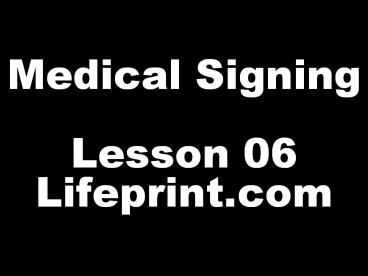Medical Signing Lesson 06 Lifeprint.com - PowerPoint PPT Presentation
Title:
Medical Signing Lesson 06 Lifeprint.com
Description:
Medical Signing Lesson 06 Lifeprint.com The same replacement (of white rice) with other whole grains, such as whole wheat and barley, was associated with a 36% ... – PowerPoint PPT presentation
Number of Views:161
Avg rating:3.0/5.0
Title: Medical Signing Lesson 06 Lifeprint.com
1
Medical SigningLesson 06Lifeprint.com
2
CONSUME The concept of "consume" when discussing
nutrition is generally expressed as a modified
form of "EAT."
3
To mean consume the sign eat is often
modified by using both hands alternately and a
bit larger movement that moves past the mouth and
down a short distance as if showing the food
going down the esophagus.
4
Consume is also expressed via a bent hand that
moves backward past the mouth and changes into an
S hand. wolf down
5
CALORIES In 1890, the USDA appropriated the
term "calorie" for a report on nutrition. A
calorie was defined as the unit of heat required
to raise 1 gram of water 1 degree Celsius.
6
Substances that provide calories
7
PROTEIN The general sign for "protein" is to
circle a "P" handshape. In some contexts some
people may choose to sign MEAT.
8
CARBOHYDRATE The sign for "carbohydrate" is to
spell C-A-R-B. (Or circle a C in context.)
9
FAT There is a version of the sign "FAT" that
means overweight. When discussing "fat" as a
food type just spell F-A-T.
10
ALCOHOL The sign for "alcohol" is the same
general sign that is used for "whiskey."
11
PROTEINCARBFATALCOHOL
12
Protein has 4 calories per gram.
13
Carbs have 4 calories per gram.
14
Fat has 9 calories per gram.
15
Alcohol has 7 calories per gram.
16
METABOLISM One of the signs for "metabolism" is
done by holding both hands in "5"-handshapes
palm-back in front of the chest. Move the hands
down, out to the side, up, and back in toward the
center a bit.
17
Memory aide Think of the sign for metabolism as
representing the movement of blood around inside
of your body.
18
Some people may use the two-handed sign "BURNING"
to mean "metabolism.
19
But when discussing nutrition and diet I prefer
to apply the "BURNING" sign for the concept of
burning calories."
20
"Energy that we use for shipping and handling
(processing) of fuels in our body is known as the
thermogenic effect of food and is equal to
approximately 10 of daily caloric intake.
21
For every 100 fat calories consumed, you expend
around 3 calories in absorption and metabolism.
22
For every 100 carbohydrate calories you consume,
your body expends 5 to 10 in absorption and
metabolism.
23
For every 100 calories of protein calories you
consume, your body needs 20 to 30 for absorption
and metabolism."
24
3,500 calories equals about 1 pound (0.45
kilogram) of fat.
25
You need to burn 3,500 calories more than you
take in to lose 1 pound of fat.
26
If you cut 500 calories from your typical diet
each day, you will lose about 1 pound a week (500
calories times 7 days 3,500 calories).
27
"Energy density is the number of calories
(energy) in a specific amount of food.
28
High energy density means that there are a lot of
calories in a little food. Low energy density
means there are few calories in a lot of food."
29
Your Resting Metabolic Rate (RMR) is responsible
for approximately 60 to 70 of your total energy
expenditure.
30
"Researchers from the Harvard School of Public
Health (HSPH) have found that eating five or more
servings of white rice per week was associated
with an increased risk of type 2 diabetes.
31
In contrast, eating two or more servings of brown
rice per week was associated with a lower risk of
the disease.
32
Replacing 50 grams of white rice (just one third
of a typical daily serving) with the same amount
of brown rice would lower risk of type 2 diabetes
by 16.
33
The same replacement (of white rice) with other
whole grains, such as whole wheat and barley, was
associated with a 36 reduced risk."
34
Greenland Eskimos, prior to the 1980s had perhaps
the lowest prevalence of both heart disease and
diabetes on the planet.
35
A 25-year study found that only one out of the
1,800 Eskomos monitored developed diabetes.
36
Eskimo diet Almost entirely fat and protein, and
only about 3 percent carbohydrates.
37
There are more than a dozen types of saturated
fat.
38
Humans predominantly consume three types of
saturated fat
39
stearic acid, palmitic acid, and lauric acid.
40
Stearic acid is converted to a monounsaturated
fat called oleic acid in your liver.
41
Carbs can be stored in your muscles and liver as
glycogen.Each gram of carbs stored in muscle is
done so with about 3 grams of water.
42
Fat requires only about 1 gram of water for each
gram of carbs stored.
43
Our muscles and liver only store up to around 500
grams of glycogen.
44
Obviously, more muscles equals more storage space
for glycogen.
45
Dr. Bill VicarsLifeprint.com































